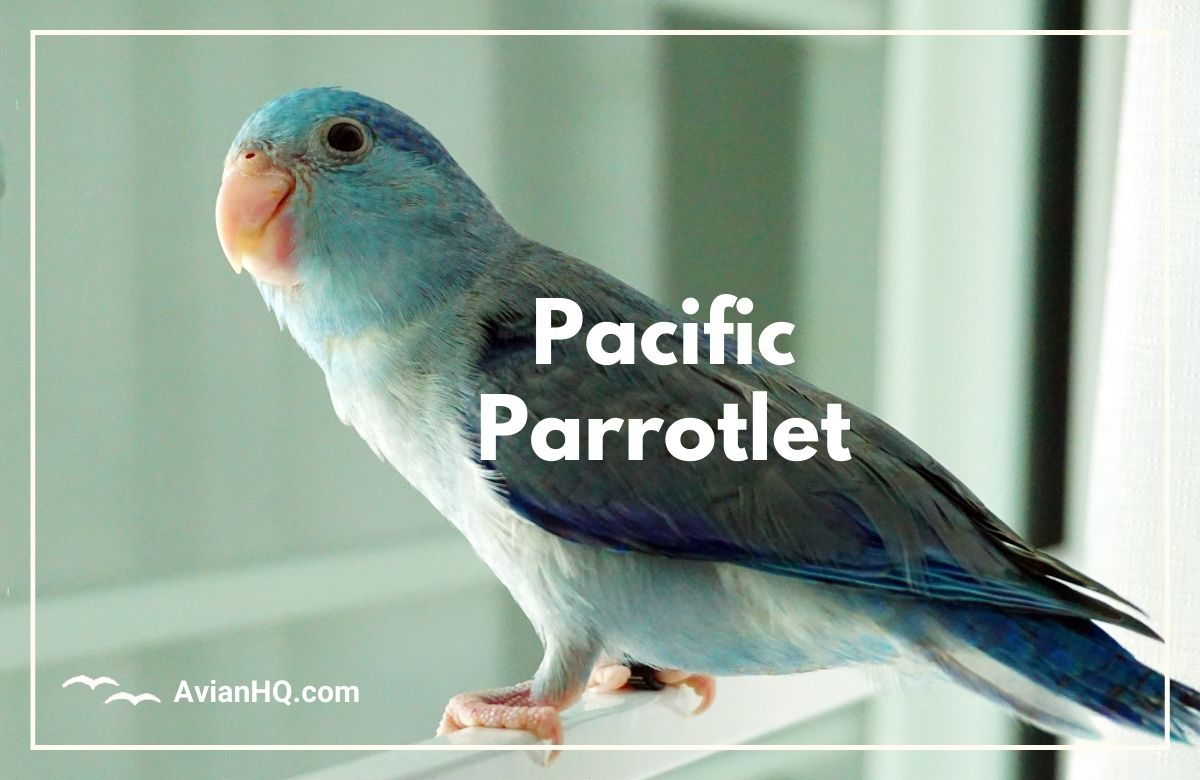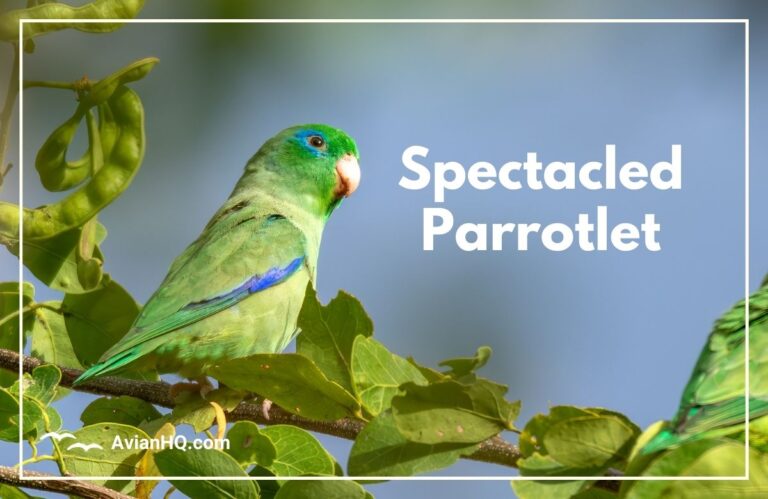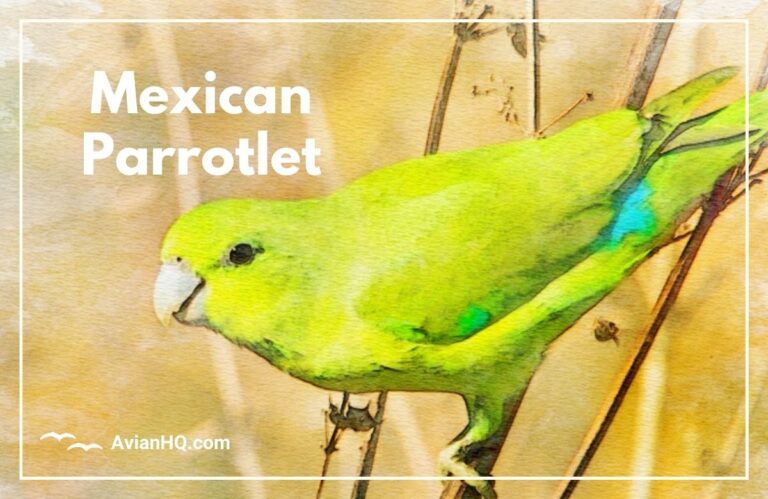Pacific Parrotlet (Forpus coelestis)
Have you ever seen a bright flash of green and blue feathers zip past you? If so, you may have spotted the Pacific Parrotlet (Forpus coelestis), one of the smallest and most colorful parrots in the world!
Measuring just 4 to 5 inches (10 to 13 centimeters) long and weighing 1 to 1.5 ounces (30 to 40 grams), the Pacific Parrotlet makes up for its tiny size with its huge personality. This petite parrot is found along the Pacific coast of South America from western Panama down through Ecuador and Peru.
While small, Pacific Parrotlets live quite a long time for such little birds – up to 15 years with proper care. They are busy and active companions that bond very closely with their owners. A Pacific Parrotlet will chatter and chirp to you throughout the day and ride along on your shoulder as you go about your routine.
Pacific Parrotlets come in a rainbow of different color mutations that make them popular as pets. The wild type has bright green upper parts, rich blue flight feathers and tail, yellowish undersides, and a rusty-red forehead spot. But through selective captive breeding, you can find Pacific Parrotlets in vibrant yellow, white, blue, and more.
In the wild, you’ll find these mini parrots living in small flocks near forest edges or clearings. They feed on seeds, fruits, buds, and the occasional insect as they acrobatically clamber through bushes and trees. But despite being common in the international pet trade, Pacific Parrotlet populations in South America are declining.
Through this article, you’ll learn all about the unique traits of the Pacific Parrotlet including its early history and taxonomy, physical appearance, habitats, behaviors, breeding habits, current conservation status, and more. While just a tiny parrot, the Pacific Parrotlet has loads of impressive features that make it a popular companion bird.
History and Taxonomy
The tiny Pacific Parrotlet was one of many parrot species first described scientifically in the 1700s as European explorers ventured to South America and documented its unfamiliar plants and animals. French naturalist Mathurin Jacques Brisson first named the species Psittacus coelestis in his 1760 work Ornithologia, basing it on a collected specimen. Over the next centuries, the Pacific Parrotlet was reclassified into several genera including Nanodes, Forpus, Xanthopsitta, and more before settling on its current designation of Forpus coelestis.
Within the genus Forpus, the Pacific Parrotlet belongs to the F. coelestis species complex found along the Pacific coast of South America. This group also includes the very similar Blue-winged Parrotlet and the Maroon-bellied Parrotlet. There is still some debate over whether the Pacific Parrotlet is a distinct species or a subspecies of the Blue-winged Parrotlet. Currently most recognize it as a full species based on differences in appearance, vocalizations, and geographical range.
Recent DNA studies suggest Pacific Parrotlets likely evolved from an ancient parrot species that colonized South America and then diverged into new forms. They are most closely related to other small Neotropical parrotlet species within the tribe Arini which includes parrotlets, parakeets, and conures. There are over 30 recognized species just within the genus Forpus! So the Pacific Parrotlet has many small, vibrant relatives across Central and South America even though it remains one of the most diminutive parrots in the world.
Physical Appearance
The Pacific Parrotlet is one of the tiniest true parrot species in the world. They reach lengths of just 4 to 5 inches (10 to 13 cm) and weigh an ounce or less – about the weight of a couple of AA batteries! Their small stature and bright colors make them utterly captivating.
Wild type Pacific Parrotlets have primarily green upperparts across the back, wings, top of the head, cheeks, and breast. Their flight feathers and short blunt tail are a deep cobalt blue that contrasts beautifully with the green. The lower breast and belly ranges from dull yellow to a rich orange or reddish color. On the forehead is a maroon-red patch of short feathers. The eyes are brown, the beak is pale gray, and the feet are zaffre gray.
One of the most conspicuous features of Pacific Parrotlets are the bright blue outer wings and tail that are often visible when perched. These vivid blue feathers help differentiate them from the very similar Blue-winged Parrotlet that has more blue-green wing patches.
There are also now many vibrant color mutations of Pacific Parrotlets thanks to captive breeding including lutino (yellow), albino, blue, cinnamon, and white. In some mutations, males and females can look nearly identical. But in wild types, males have brighter richer colors on the forehead, wings, and tail while females appear somewhat duller. Juveniles also lack the bright colors until their first molt.
With their tiny bodies, short blunt tail, and curved beak, Pacific Parrotlets are specially adapted for clambering acrobatically through trees and bushes while feeding. Strong feet allow them to tightly grip branches and wires. And unusually long flight feathers give these tiny parrots incredible aerial agility and speed.
Habitat and Distribution
Pacific Parrotlets are found along the western coast of South America by the Pacific Ocean. Their range stretches along the coast from central Panama down through western Colombia, Ecuador, and northern Peru. Within this narrow coastal range, you’ll find them inhabiting forest and woodland areas from sea level up to altitudes of 7,500 feet (2,300 meters).
Pacific Parrotlets prefer drier forests, scrublands, and thickets rather than rainforests. They especially like forest edges, clearings, and areas with bushes and small trees that provide openings and edges. Common trees include acacias, cecropias, eucalyptus and conifers. The climate is generally hot and humid but cooler and drier at higher elevations.
Though centered along the Pacific coast, small introduced populations of Pacific Parrotlets have become established in areas like Lima, Peru and even as far away as Hong Kong and Japan through the cage bird trade. But their native habitat and ancestry lies along the Pacific coast of Central and South America.
Across most of their narrow 620 mile long range from Panama to Peru, Pacific Parrotlet populations appear relatively stable. But they face threats from deforestation and have vanished from areas where forests have been heavily logged. Protecting their dry forest habitat will be key to the long term survival of the species across its limited endemic range.
Diet and Feeding
The Pacific Parrotlet is adapted for clambering through bushes and trees to feed on fruits, seeds, buds, and some insects. Their diet varies based on food availability across forests, woodlands, and scrub habitats.
Fruits make up a major part of their diet including figs, berries, and small fleshy fruits. They use their curved parrot beak to dig into fruit to reach the flesh and seeds inside. Seeds from grasses and plants like thistles supplement their fruit intake.
Pacific Parrotlets also feed on new shoots, buds, blossoms to get essential fats and protein. You may see them leaving a trail of shredded flower petals in their wake! They occasionally snack on small arthropods like insects for extra protein. A varied diet provides balanced nutrition.
In captivity, the basic diet should include a quality parrot seed mix along with pellets to round it out. Chopped fruits and vegetables like apples, oranges, beans, carrots, and greens offer variety. Sprouted and germinated seeds are readily accepted too. Supplements like cuttlebone give them necessary calcium, minerals, and grit.
Wild Pacific Parrotlets usually feed in small flocks for safety from predators. You’ll see them active in short bursts during the day, aggressively climbing through bushes, nibbling on fruits and buds, then returning to a sheltered perch to rest. At favorite food sources like a fruiting tree, hundreds may gather at once, creating a sight of constantly swirling green feathers dotted with bright blue! Their feeding style perfectly matches their active, social nature.
Breeding and Reproduction
Pacific Parrotlets reach breeding age around 18 months old. They form monogamous pair bonds that can last for life. Though small, they are fiercely protective parents.
The breeding season runs from January through August which corresponds to the drier season in their native range. To attract a mate, males put on spectacular flying displays while making loud sputtering and whistling vocalizations.
Once paired, the couple collaboratively chooses a nest site in a naturally protected area – usually an old woodpecker hole or other tree cavity up to 65 feet (20 meters) above ground. They line the inner cavity with wood chips and feathers.
The female then lays a small clutch of 3 to 5 tiny white eggs at intervals of 1 to 2 days. She incubates them alone for about 24 days while the male feeds her. The chicks hatch out covered in pale yellow down. At first the female broods them while the male brings food. Later both parents gather food for the chicks in their crops to regurgitate feed them.
This continuous effort allows the chicks to grow rapidly. They fledge at around 6 weeks old but stick close to their parents learning survival skills for several more weeks. From start to finish, the breeding cycle lasts 3 to 4 months. Most pairs raise one or two clutches each year.
In captivity, Pacific Parrotlets should have next boxes at least 8 inches (20 cm) deep with a 2 inch (5 cm) entrance hole. Providing proper conditions and diet often results in repeated successful breeding.
Behavior and Ecology
Pacific Parrotlets are busy, active little birds that spend most of their time rapidly climbing through bushes and trees or flying in compact flocks. Their behavior and adaptations let them thrive in their forest and scrubland home ranges along the Pacific coast.
They are highly social, usually traveling in small groups of 10 to 30 birds. Larger flocks may form where food is abundant. All members roost communally in dense thickets or tree cavities at night for safety. Their bright green plumage and loud piercing calls make it easy to keep track of their flock mates.
Roosting and nesting spots are aggressively defended from intruders and predators. But Pacific Parrotlets have many threats including snakes, hawks, falcons, owls, and other birds. Their main survival strategy is to detect any danger immediately through vigilance and loud alarm calls. Flocks then quickly disperse to safety.
Pacific Parrotlets are most active in short bursts during mornings and evenings. After aggressively feeding they become quiet and rest while digesting. You’ll know they are nearby when you hear their remarkably loud voices – a series of sputtering chips, chirps, squeals, whistles and trills.
Bold and curious by nature, they readily adapt to new environments. This allows some populations to thrive near human settlements as long as suitable nesting spots and food exist.
Conservation Status
The Pacific Parrotlet is currently listed as a species of Least Concern by the International Union for Conservation of Nature (IUCN). Across most of its natural range from Panama to Peru, populations appear relatively stable and the species remains common.
However, they face threats from habitat loss as forests are logged or converted to agricultural land across parts of their range. Over the past decades they have disappeared from some districts in Colombia, Ecuador and Peru where little intact dry forest remains.
Pacific Parrotlets are also frequently taken from the wild for the pet trade. Up to 19,000 parrotlets of various species are estimated to be exported each year from South America. Though commercial trapping has less impact on more common species like the Pacific Parrotlet compared to threatened species, it can put additional pressure on populations.
In areas near human settlements, Pacific Parrotlets readily nest in power transformers where they are sometimes killed by electric shocks. Feral birds in expanded habitats like Hawaii and Japan compete with native birds for nest sites. And climate change may alter forest habitats across their limited range.
Protecting pockets of remaining dry and mountain forest across western South America that offer suitable nesting and feeding habitat will be key to ensuring thriving Pacific Parrotlet numbers for the future. Though small, they play an integral role in forest ecosystems through seed dispersal and pollination.
Cultural Significance
The brilliant plumage and diminutive size of Pacific Parrotlets have attracted the attention of indigenous South American cultures and modern bird enthusiasts alike.
Among pre-Colombian cultures like the Chimú and Moche living along the Peruvian coast, the Pacific Parrotlet was depicted in art and pottery as a messenger linked to rain and fertility. Feathers from parrotlets and other small parrots were likely used ceremonially and in elite headdresses.
Many modern indigenous groups view parrots as bringing vibrancy, joy, and communication to the world through their voices and color. Across South and Central America, parrots remain symbols celebrating life even while facing threats in the wild.
Pacific Parrotlets have also become extremely popular as pets and aviary birds worldwide thanks to captive breeding programs making them widely available. Their small size, bright colors, intelligence, longevity and energetic personalities make them appealing companion birds able to form strong bonds with caregivers.
Vibrant mutations like rare whites, blues, and yellows are especially prized. Their antics climbing all over their environment, hanging upside down, vocalizing loudly, and interacting with owners continually draw interest and affection from devotees. Even weighing less than an ounce, Pacific Parrotlets leave a large imprint through their cultural symbolism and captive popularity.
Conclusion
The Pacific Parrotlet may be tiny, but it packs huge personality and color into its small frame! One of the smallest true parrots in the world, these birds fill an important niche in the dry forests and woodlands along South America’s Pacific coast.
Their bright plumage and loud voices keep flock mates in contact as they acrobatically climb through trees and shrubs foraging for fruit, seeds, and flowers. Though diminutive, Pacific Parrotlets are fiercely dedicated parents, aggressively defending their nest holes against predators and intruders.
Pacific Parrotlets adapt readily to living near human settlements and show endless curiosity about their surroundings. These traits have made them extremely popular cage birds able to form close bonds with devoted owners. Their small size at just 4 to 5 inches (10 to 13 cm) makes them ideal for apartments. But their outsized personalities give them huge appeal.
In the wild, Pacific Parrotlets fill vital roles dispersing seeds, pollinating plants, and propagating forests across their range from Panama to Peru. Protecting areas of remaining dry forest and woodland habitat within their limited endemic distribution will allow future generations to enjoy their charm.
The fiery colors and vocal exuberance of the Pacific Parrotlet brighten bird enthusiasts and ecologists alike. If you want to bring a burst of energy into your home, consider adopting one of these pocket-sized companions! Their colorful feathers and perky personality will fill your days with life.






